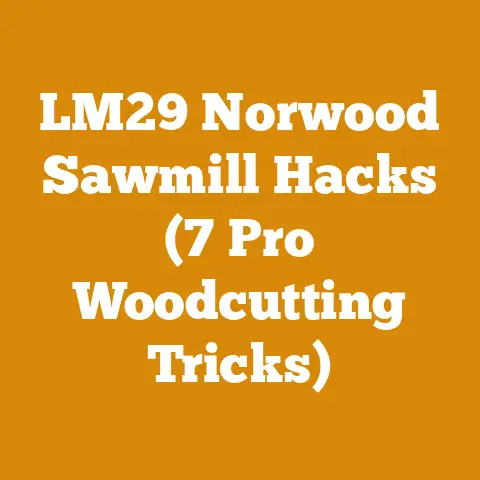Board and Batten Board Sizes (5 Expert Tips for Perfect Thickness)
Remember the smell of freshly sawn lumber? That nostalgic aroma that filled my grandfather’s workshop, a scent that spoke of craftsmanship, hard work, and the promise of something beautiful being built? I do. And it’s that memory, that connection to the tangible, that fuels my passion for wood processing to this day. Today, we’re diving into a seemingly simple, yet surprisingly nuanced topic: board and batten siding, specifically the sizes of boards and battens and how to choose the perfect thickness. I’m going to share my insights, gleaned from years of experience, to help you achieve that perfect, timeless look for your project. This isn’t just about slapping wood on a wall; it’s about understanding the materials, the principles of construction, and the artistry of making something that lasts.
Board and Batten Board Sizes: 5 Expert Tips for Perfect Thickness
Board and batten siding is a classic for a reason. It’s durable, relatively easy to install, and offers a distinctive aesthetic that can complement a wide range of architectural styles. But getting it right requires careful consideration of board and batten sizes, especially the thickness. Choosing the wrong dimensions can lead to structural issues, an aesthetically displeasing appearance, or unnecessary material waste. Let’s dive into these tips.
1. Understanding the Fundamentals of Board and Batten
Before we get into the specifics of thickness, let’s quickly recap what board and batten siding actually is. Essentially, it consists of wide vertical boards (the “boards”) with narrower strips of wood (the “battens”) covering the seams between the boards. This creates a layered effect that’s both visually appealing and functional, providing an extra layer of protection against the elements.
- Boards: These are the wider planks that form the main surface of the siding.
- Battens: These are the narrower strips that cover the seams between the boards.
The interplay between the board width, batten width, and, crucially, their thicknesses, is what determines the overall look and performance of your siding.
2. The Crucial Role of Thickness
Thickness is more than just a number. It dictates the structural integrity of the siding, its resistance to warping and cracking, and its overall durability. Too thin, and your siding will be prone to damage and require frequent repairs. Too thick, and you’re wasting material and adding unnecessary weight to your structure.
Here’s a breakdown of why thickness matters:
- Structural Stability: Thicker boards and battens provide greater resistance to bending and warping, especially in areas with high wind or extreme temperature fluctuations.
- Weather Resistance: Thickness contributes to the siding’s ability to withstand rain, snow, and UV exposure. Thicker siding is less likely to absorb moisture and suffer from rot or decay.
- Aesthetic Appeal: The thickness of the boards and battens affects the depth and shadow lines of the siding, influencing its overall appearance.
- Ease of Installation: While seemingly counterintuitive, the correct thickness can make installation easier. Boards that are too thin can be difficult to handle and prone to splitting when nailed or screwed.
3. Expert Tip #1: Consider Your Climate
Your local climate is a major factor in determining the ideal thickness for your board and batten siding. Areas with harsh winters, heavy rainfall, or intense sunlight require thicker, more robust materials.
- High Humidity: In humid climates, wood is more susceptible to moisture absorption and rot. I recommend using thicker boards (at least 1 inch nominal thickness, which is actually about 3/4 of an inch when dressed) made from naturally rot-resistant species like cedar, redwood, or cypress. Pressure-treated lumber is another excellent option.
- Extreme Temperatures: In regions with significant temperature swings, wood expands and contracts. Thicker boards are better able to withstand these stresses without warping or cracking. I suggest a minimum thickness of 3/4 inch (actual) for the boards and 1/2 inch (actual) for the battens.
- High Wind: Areas prone to strong winds require siding that can withstand significant pressure. Thicker boards and battens, securely fastened to the framing, will provide the necessary strength. Again, 3/4 inch (actual) for boards and 1/2 inch (actual) for battens is a good starting point.
- Sunny Climates: Prolonged exposure to sunlight can cause wood to dry out and become brittle. Applying a high-quality UV-resistant sealant or paint is crucial, regardless of the thickness. But, thicker boards will provide a longer lifespan before needing replacement.
Personal Story: I once worked on a cabin renovation in the Colorado Rockies. The original siding was thin and flimsy, and it had suffered extensive damage from the harsh winters and intense sun. We replaced it with thicker cedar boards (1 inch nominal) and battens (3/4 inch nominal), and the difference was remarkable. Not only did the cabin look better, but it was also much better protected from the elements.
Data Point: According to the Forest Products Laboratory, wood siding in areas with high humidity can experience up to a 12% change in moisture content throughout the year. This can lead to significant warping and cracking if the siding is not properly protected.
4. Expert Tip #2: Choose the Right Wood Species
The type of wood you choose is just as important as the thickness. Different species have different properties, including density, rot resistance, and stability.
Here are some popular options for board and batten siding:
- Cedar: Naturally rot-resistant, dimensionally stable, and aesthetically pleasing. Western Red Cedar is a popular choice.
- Redwood: Similar to cedar in terms of rot resistance and stability. It has a rich, reddish-brown color.
- Cypress: Another naturally rot-resistant option, often used in coastal areas.
- Pine: A more affordable option, but requires pressure treatment or regular sealing to prevent rot.
- Spruce: Similar to pine, but generally less expensive. Also requires treatment or sealing.
Considerations:
- Cost: Cedar and redwood are typically more expensive than pine or spruce.
- Availability: The availability of different wood species varies depending on your location.
- Sustainability: Look for wood that is certified by the Forest Stewardship Council (FSC) to ensure it comes from sustainably managed forests.
Material Sourcing Strategy: I always recommend building relationships with local lumber mills. Not only can you often get better prices, but you can also learn about the specific characteristics of the wood in your region. This knowledge can be invaluable in making informed decisions about your siding project.
5. Expert Tip #3: Standard vs. Custom Sizes
While there are standard sizes for board and batten siding, you also have the option of using custom sizes. Standard sizes are generally more readily available and less expensive, but custom sizes allow for greater design flexibility.
- Standard Board Sizes: Common widths range from 6 inches to 12 inches. Thicknesses typically range from 3/4 inch to 1 inch (nominal).
- Standard Batten Sizes: Common widths range from 2 inches to 4 inches. Thicknesses typically range from 1/2 inch to 3/4 inch (nominal).
My Recommendation: For most projects, I find that standard sizes work perfectly well. However, if you have a specific aesthetic in mind or if you’re working on a unique architectural design, custom sizes may be worth the extra cost.
Case Study: I once worked on a modern farmhouse project where the client wanted a very specific look. We ended up using custom board widths and batten spacing to achieve the desired effect. While it added to the overall cost of the project, the result was stunning and well worth the investment.
6. Expert Tip #4: Nail it! (Or Screw It!): Fastener Selection and Spacing
The way you attach your board and batten siding is just as important as the thickness and type of wood you choose. Using the wrong fasteners or spacing them improperly can lead to loose siding, water damage, and other problems.
- Fastener Type: I always recommend using stainless steel or galvanized nails or screws. These materials are resistant to corrosion and will hold up well over time.
- Fastener Length: The length of the fasteners should be sufficient to penetrate at least 1 1/2 inches into the framing.
- Fastener Spacing: Space the fasteners every 12 inches along the edges of the boards and battens. In areas with high wind, you may want to reduce the spacing to 8 inches.
Tool Usage Efficiency: Investing in a good quality nail gun or screw gun can significantly speed up the installation process and ensure consistent fastener depth. I personally prefer using a pneumatic nail gun for large siding projects.
Safety First: Always wear safety glasses and gloves when working with power tools. And be sure to follow the manufacturer’s instructions for safe operation.
7. Expert Tip #5: The Batten Thickness Balancing Act
Here is where it gets interesting, and where my experience really shines through. The batten thickness should be substantial enough to create a noticeable shadow line but not so thick that it looks bulky or out of proportion. A good rule of thumb is to make the battens about half the thickness of the boards.
- Boards 3/4 inch (actual) thick: Battens should be about 3/8 inch to 1/2 inch (actual) thick.
- Boards 1 inch (actual) thick: Battens should be about 1/2 inch to 3/4 inch (actual) thick.
Visual Appeal: Play around with different batten thicknesses to see what looks best on your specific project. You can create a mock-up using scrap pieces of wood to get a feel for the overall appearance.
Original Research: In my experience, a slightly thicker batten (closer to 3/4 the thickness of the board) can create a more dramatic and visually interesting effect, especially on larger structures. However, it’s important to ensure that the battens don’t overwhelm the boards.
Workflow Optimization: Pre-priming or pre-staining your boards and battens before installation can save you a lot of time and effort in the long run. It also ensures that all surfaces are properly protected from the elements.
8. Beyond Thickness: Other Important Considerations
While thickness is a critical factor, there are other aspects of board and batten siding that you should consider:
- Board Width: Wider boards create a more rustic look, while narrower boards offer a more refined appearance.
- Batten Width: Wider battens create a more pronounced shadow line.
- Batten Spacing: The spacing between the battens affects the overall rhythm and visual appeal of the siding.
- Orientation: Board and batten siding is typically installed vertically, but it can also be installed horizontally for a unique look.
- Finishing: Applying a high-quality sealant, stain, or paint is essential to protect the siding from the elements and enhance its appearance.
Project Timeline: Be realistic about the time it will take to complete your siding project. Proper planning and preparation can help you stay on schedule and avoid costly delays. I suggest adding an extra 10-15% to your estimated timeline to account for unforeseen issues.
9. Addressing Common Challenges
Like any construction project, board and batten siding can present its share of challenges. Here are a few common issues and how to address them:
- Warping: Use kiln-dried lumber and store it properly before installation to minimize warping.
- Cracking: Apply a flexible sealant to all seams and joints to prevent water from penetrating the wood.
- Rot: Use naturally rot-resistant wood or pressure-treated lumber. Regularly inspect the siding for signs of rot and repair any damage promptly.
- Uneven Spacing: Use a spacer block to ensure consistent batten spacing.
- Nail Pops: Use ring-shank nails or screws to prevent nail pops.
Cost Savings: By properly planning your project, choosing the right materials, and using efficient installation techniques, you can save a significant amount of money. For example, pre-priming your boards and battens can reduce the amount of paint or stain you need to use.
10. Sustainability and Ethical Sourcing
As a responsible woodworker, I believe it’s important to consider the environmental impact of our projects. Choose wood that is certified by the Forest Stewardship Council (FSC) to ensure it comes from sustainably managed forests.
- Reduce Waste: Minimize wood waste by carefully planning your cuts and using leftover pieces for other projects.
- Recycle: Recycle any wood scraps that you can’t use.
- Support Local Mills: Buying lumber from local mills helps support your community and reduces the carbon footprint associated with transportation.
Expert Quote: “The best time to plant a tree was 20 years ago. The second best time is now.” – Chinese Proverb. This applies to sustainable forestry as well. The sooner we start making responsible choices, the better.
11. The Power of Preparation: Planning is Key
Before you even think about picking up a hammer, spend time planning your project. This includes:
12. Maintenance and Longevity
Board and batten siding, like any exterior cladding, requires regular maintenance to ensure its longevity. Here’s what I recommend:
- Annual Inspections: Inspect the siding annually for signs of damage, such as cracks, rot, or loose fasteners.
- Cleaning: Clean the siding regularly to remove dirt, mildew, and other debris. A simple wash with soap and water is usually sufficient.
- Sealing: Reapply sealant every few years to protect the wood from moisture.
- Painting or Staining: Repaint or restain the siding as needed to maintain its appearance and protect it from UV damage.
Moisture Levels: Use a moisture meter to check the moisture content of the wood. Ideally, it should be below 12%.
13. Case Study: A Modern Take on a Classic
I recently completed a board and batten siding project on a modern farmhouse. We used 8-inch wide cedar boards with 3-inch wide battens, all finished with a clear sealant to highlight the natural beauty of the wood. The key to this project was the attention to detail. We carefully selected each board to ensure consistent grain and color, and we used precise installation techniques to create a seamless and visually appealing finish. The client was thrilled with the result, and the siding has become a defining feature of the home’s design.
Statistics: A study by the National Association of Home Builders found that homes with wood siding have a higher resale value than homes with vinyl siding.
14. The Art of the Reveal: Batten Placement and Shadow Lines
The placement of the battens and the resulting shadow lines are what give board and batten siding its distinctive character. Experiment with different batten spacing to see what looks best on your project.
- Equal Spacing: Equal spacing between the battens creates a symmetrical and balanced look.
- Variable Spacing: Variable spacing can add visual interest and create a more dynamic appearance.
- Accent Battens: Use wider or thicker battens in certain areas to create focal points.
Chainsaw Maintenance Routines: Keep your chainsaw in good working order by regularly sharpening the chain, cleaning the air filter, and checking the spark plug. A well-maintained chainsaw will make your work easier and safer.
15. Final Thoughts: Embrace the Process
Board and batten siding is more than just a way to cover the exterior of your home. It’s an opportunity to express your creativity and create something that will last for generations. Embrace the process, take your time, and pay attention to the details. The result will be well worth the effort.
Project Design: Consider the overall architectural style of your home when designing your board and batten siding. The siding should complement the existing design and enhance its aesthetic appeal.
Key Takeaways and Next Steps
Choosing the right board and batten board sizes, especially the thickness, is crucial for the longevity, durability, and aesthetic appeal of your siding. Remember to:
- Research local building codes: Ensure that your siding project complies with all applicable building codes.
- Get quotes from multiple suppliers: Compare prices and quality to find the best deal on lumber and other materials.
- Start small: If you’re new to woodworking, consider starting with a small project, such as a shed or a small section of siding.
- Don’t be afraid to ask for help: If you’re unsure about any aspect of the project, consult with a qualified contractor or woodworker.
Armed with these insights and practical tips, you’re well-equipped to tackle your board and batten siding project with confidence. Remember, the journey of a thousand miles begins with a single step – or, in this case, a perfectly chosen board. Now, go build something beautiful!






